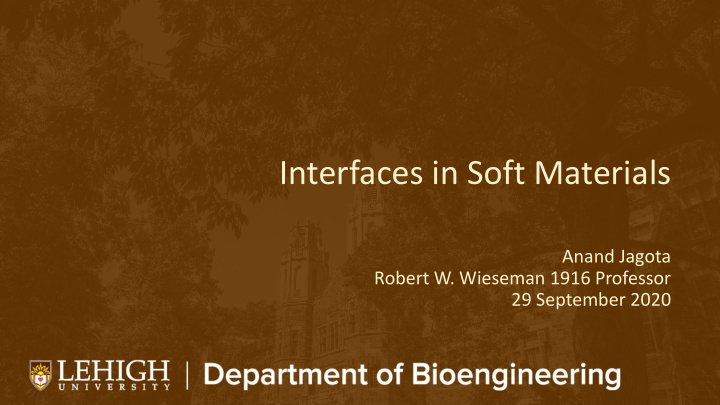



Interfaces in Soft Materials Anand Jagota Robert W. Wieseman 1916 Professor 29 September 2020
PI Background • Education • Indian Institute of Technology New Delhi, (India). Bachelor of Technology in Mechanical Engineering (1983). • Cornell University Ithaca, New York (USA). PhD in Mechanical Engineering (1988). • Experience (abbreviated) • The DuPont Company, Senior Research Scientist, 1988 – 1994; 1996-2004. • Lehigh University, Professor and Founding Chair of Bioengineering and Professor of Chemical & Biomolecular Engineering (2004 – present) • Research : Broadly in Interfacial Mechanical Properties of Soft Materials. • Keywords : Carbon Nanotubes, DNA, Surface stress, Biomimetic Materials, Adhesion, Friction, Viral Adhesion. • Selected Publications • Ming Zheng, Anand Jagota, et al.,“DNA-Assisted Dispersion and Separation of Carbon Nanotubes" Nature Materials, 2 338-342 (2003). • Robert W. Style, et al. "Elastocapillarity: Surface tension and the mechanics of soft solids." Annual Review of Condensed Matter Physics 8 (2017): 99-118. • A Jagota, CY Hui,” Adhesion, Friction, and Compliance of Bio-mimetic and Bio-inspired Structured Interfaces, Materials Science and Engineering: R: Reports 72 (12) 253-292 (2011).
Biomimetic Surface Architecture for DNA/Single-Wall Carbon Adhesion and Friction Nanotube Hybrids Enhanced Elasto-Hydrodynamic Friction By Biomimetic Surface Design Applications : Synovial joints to tires on a road F Applications : Near-IR Optical Biosensors V (Molecular Perceptron). Fluorescence intensity and wavelength is modulated by analyte. A combination of several hybrids acting together with machine learning tools works as a biosensor. (10,5) (10,2) (9,4) (8,6) (8,7) (8,3) (7,5) (9,5) (7,6) (6,5) (8,4) Perceptive model Input data: Analytes detection Selective Control of Adhesion and DNA sequences, SWCNT chirality, Friction by Biomimetic Shape peak position, Complementary Interfaces Results in PL intensity, etc... Arrays of Meso-Scale Screw and Edge Dislocations.
Biomechanics of Viral Elastocapillarity of Soft Adhesion Solids Soft material surfaces carry surface stress that affects Initial adhesion of a virus to the cell membrane is a precursor to its entry a variety of surface mechanical phenomena. This is a into the cell. We are working to understand the biomechanics of this pervasive effect that had been ignored until recently. process in two ways: (a) by continuum models of virus/membrane We are studying a variety of surface mechanical interaction, and (b) coarse-grained molecular simulation. phenomena influenced or dominated by surface stress. A continuum model for Ebola virus adhesion to the cell A hydrogel removed from its membrane reveals that the PDMS mold changes to a process is dominated by two relaxed shape under the dimensionless variables. influence of surface stress. When one of them, a normalized adhesion, is smaller than a critical value, the virus does not stick to the cell membrane. Partial wetting of drops on a soft A coarse-grained molecular model of surface is changed due to surface the binding between a receptor on stress. Young’s equation is no the cell membrane (TIM family) and longer valid. phosphatidylserine (PS) on the virus surface. The model shows how length of TIM makes it easier for it to bind to PS.
Jagota Laboratory • We combine experiment, theory, and simulation in our work. • The group is highly collaborative internally, and we also work with a number of other labs at Lehigh and elsewhere. • Visit our website at https://wordpress.lehigh.edu/anj6/ or write to Prof. Jagota at anj6@lehigh.edu
Recommend
More recommend